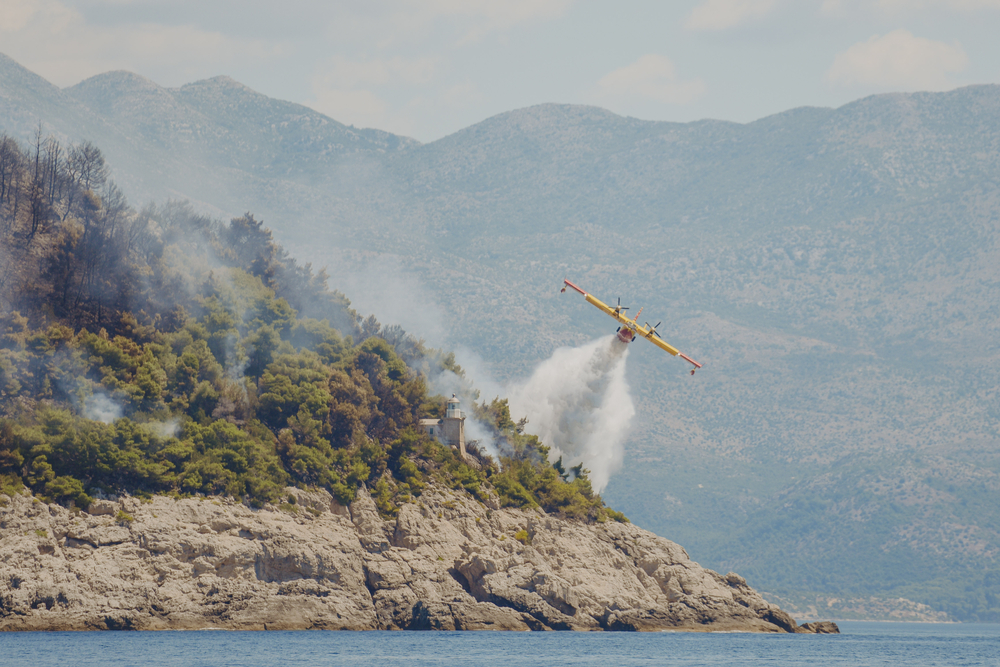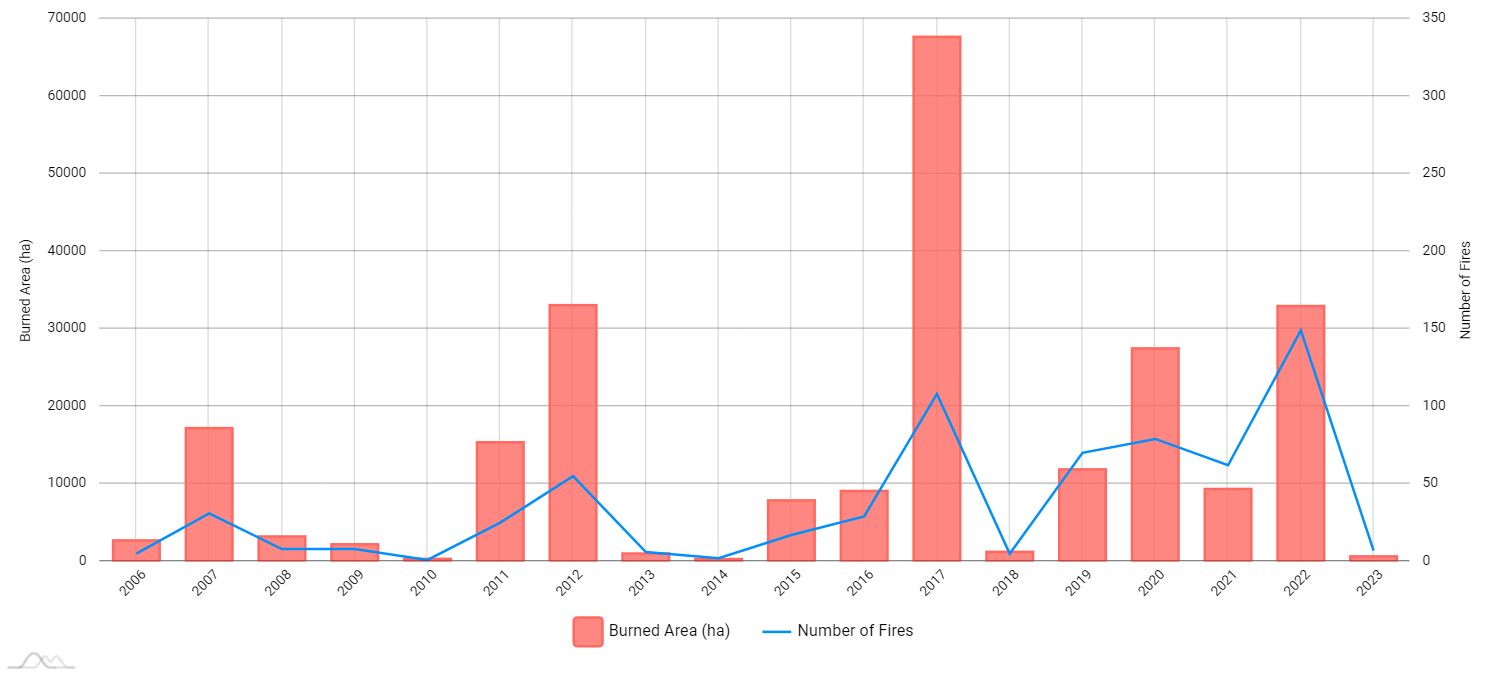
Forest fire near Dubrovnik (© Fraser Takes Photos/Shutterstock)
Last year Croatia’s coastal region was hit by an intense wave of forest fires, one of the worst in recent years. But the country has been gearing up to cope – partly thanks to EU funding.
Translation by Harry Bowden | Voxeurop
The summer of 2022 was one of the most traumatic yet along the Croatian coast. An intense wave of forest fires, one of the worst in the last decade, ravaged the region. More than 30,000 hectares of land were burnt. The flames destroyed homes and businesses as well as trees, and forced the evacuation of thousands of residents and tourists. Although the affected surface area was smaller than in 2012 or 2017 (other terrible years), there was a record number of individual fires in the region. Even Istria, which is usually spared from the flames, saw a considerable spike in firefighter interventions compared to previous years.
Source: EFFIS
The causes
How can these fires be explained? As detailed in a recent study by the United Nations University's Institute for Environment and Human Security, the climate crisis has made it easier for forest fires to degenerate into what are called "extreme fires", i.e. events that end up beyond human control. The problem is aggravated by uncontrolled development and poor awareness of forest-management best practice. Global warming is certainly the main culprit, but in Croatia there are some pre-existing specificities that increase the risk of extreme fires.
Stanislava Odrljin is a Zagreb-based landscape architect who has studied such fires. In her view, the concept of "secondary ecological succession" needs to be considered before one can discuss Croatia's unique features. "Everything starts in bare ground, without vegetation and uncontaminated by human intervention. In this soil, the first plants that grow are very resistant. We would call them 'weeds'. Then other species gradually arrive. This happens because the first plants make the soil more hospitable and fertile, allowing more delicate species to grow there, thus expanding the biodiversity of the area. The phenomenon is known as secondary ecological succession and it is a cycle that occurs naturally and regularly in the Mediterranean ecosystem," explains Odrljin. "Usually, this cycle ends when a fire wipes out the vegetation, and the succession can then start again."
The events of the last hundred years have changed the landscape of the Croatian coast, making it more susceptible to extreme fires. "Dalmatia was once rich in vineyards and terraced fields," says Stanislava Odrljin. "This mosaic of different crops was good for biodiversity and played an important role in fire prevention, but it was lost over time. In the 1950s, agriculture went through a serious crisis and many fields were abandoned." In abandoned fields, the cycle of secondary ecological succession does not function as it should, "because these are soils whose characteristics have been altered by human intervention".
Odrlijn explains: "The plants that have grown on Dalmatia's former farmland have sprung up close to each other, and have created a dense network of vegetation where dead plants, dry leaves, and so on accumulate. This makes for a large amount of highly flammable material that, combined with climate change and other factors, makes the area more susceptible to extreme forest fires, such as those that hit the coast last summer."
Clearing abandoned fields might therefore seem like a rather easy and straightforward solution. But it clashes with another problem typical of the Croatian countryside: the fragmentation of property. "Some areas on the coast, such as regional and national parks, are under state management and are constantly and carefully looked after. Abandoned fields, on the other hand, are mostly in private hands and there are almost always multiple owners involved, sometimes living abroad. This means that the areas most at risk are the ones that are most difficult to take care of," says the landscape architect.
Attempts at solutions
Despite these characteristics that make Croatia more prone to extreme fires, much has been done in recent years to improve the situation.
Dijana Vuletić is a scientific advisor at the Croatian Forest Research Institute. Between 2013 and 2016, within the framework of the Division for International Scientific Cooperation in South-Eastern Europe (EFISEE ), she was in charge of a large project aimed precisely at preventing and managing extreme fires and other natural disasters. Known as HOLISTIC (or Adriatic Holistic Forest Fire Protection) and financed by the EU-funded Adriatic cross-border cooperation programme, the initiative enabled (among other things) the installation of cameras along the coast and the purchase of modern equipment to improve the capabilities of the Croatian fire brigade.
"The HOLISTIC project was thus named because it did not deal with just one aspect of the phenomenon, such as fire prevention or response, but sought to find solutions for each aspect, and tried to involve all stakeholders, from individuals to local communities and schools. One of the objectives was to educate the population about forest fires," explains Dijana Vuletić. "For example, we have carried out several campaigns to encourage citizens to adopt responsible behaviour from an early age. Indeed, most of the fires in Croatia were caused by arson. Changing our attitude towards nature is one of the main goals."
"Unfortunately, there is still a significant amount of rubbish in the forests and many individuals are not much bothered by this. They light bonfires and organise barbecues without considering the potential risks – and if something goes wrong they tend to leave the area without taking responsibility. To really change the situation we need continuous awareness-raising and education campaigns. Temporary projects are not enough", says Vuletić.
New projects
The HOLISTIC project was followed by new European projects in 2021, including FIRE-RES and SILVANUS . The latter (whose full name is “Integrated Technological and Information Platform for Wildfire Management") also directly involves Croatia.
“SILVANUS is a large project with a budget of €24 million, €19.9 million being financed by the European Commission. It involved 49 organisations from Europe, but also from Indonesia, Brazil and Australia, says Lovorko Marić, the project’s dissemination manager.” Taking the same holistic approach – that is, fire prevention as well as response, restoration and adaptation – the SILVANUS project aims specifically to "create an innovative technological platform to help manage forest fires".
“New cameras will be tested within the SILVANUS pilot exercises.”, explains Marić. “In terms of fire prevention and emergency response, we are working on an augmented-reality programme to train firefighters, and we are also deploying drones, ground robots, sensors and other technological tools to better manage fires." “These new technologies will be tested in the field through twelve pilots.” "Each pilot project will respect the peculiarities of the country. In Portugal, for example, we will specifically address the potential impact and prevention strategies for fires close to transmission lines that might affect the electricity distribution, and the consequences faced by the community in the event of breaches."
The pilot exercise in Croatia in Croatia took place in April 2023 at the Training centre Šapjane, located close to Rijeka. Among the participants was Željko Cebin, who has been a member of the Croatian Fire Brigades Association since 2019. "Croatian Firefighting Association has received 160,000 € of funds for the entire project" recounts Željko Cebin. "We tried out different technological tools. For example, there was an exercise involving the containment and extinguishing of fires by firefighters with the help of various ground and aerial vehicles, while in the second part of the exercise it was robots that took care of the fire."
This summer is already shaping up to be one of the hottest ever. It will be a chance to test not only these new tools, but also the awareness of citizens – who unfortunately still bear responsibility for most of Croatia's fires.
This material is published in the context of the "FIRE-RES" project co-funded by the European Union (EU). The EU is in no way responsible for the information or views expressed within the framework of the project. Responsibility for the contents lies solely with OBC Transeuropa. Go to the FIRE-RES page



































 To Top
To Top